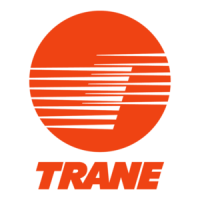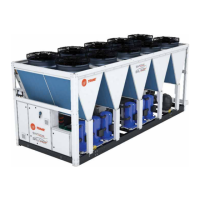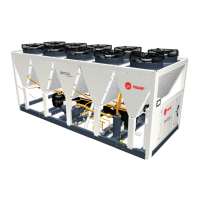8
CG-SVX039C-GB
Pre-Installation
Inspection Checklist
When the unit is delivered, verify that it is the correct
unit and that it is properly equipped. Compare the
information which appears on the unit nameplate with
the ordering and submittal information.
Inspect all exterior components for visible damage.
Report any apparent damage or material shortage to
the carrier and make a “unit damage” notation on the
carrier’s delivery receipt. Specify the extent and type of
damage found and notify the appropriate Trane Sales
Office. Do not proceed with installation of a damaged
unit without sales office approval.
Mandatory Start-up Checklist
This checklist is not intended to be a substitution for
the contractor’s installation instruction. This checklist is
intended to be a guide for the Trane technician just prior
to unit ‘start-up’. Many of the recommended checks and
actions could expose the technician to electrical and
mechanical hazards. Refer to the appropriate sections in
the unit manual for appropriate procedures, component
specifications and safety instructions.
Except where noted; it is implied that the technician is to
use this checklist for inspection/verification of prior tasks
completed by the general contractor at installation.
1. Unit clearances adequate for service and to avoid
air recirculation, etc.
2. Unit exterior inspected. CGAF/CXAF condenser
coil will not be obstructed at any time by snow or
ice during winter conditions
3. Unit properly grounded
4. Crankcase heaters working for 24 hours prior to
arrival of Trane technician performing start-up
5. Correct voltage supplied to unit and electric
heaters (imbalance not to exceed 2%)
6. Unit power phasing (A-B-C sequence) proper for
compressor rotation
7. Copper power wiring meets sizing requirement in
job submittal
8. All automation and remote controls installed/
wired
9. All wiring connections tight
10. Prove chilled water side Interlock and
Interconnecting
11. Wiring Interlock and externals (chilled water
pump)
12. Field installed control wiring landed on correct
terminals (external start/stop, emergency stop,
chilled water reset…)
13. Verify all refrigerant and oil valves are open/back
seated
14. Compressor oil levels (1/2 -3/4 high in glass)
proper
15. Verify chilled water strainer is clean and free of
debris and evaporator chilled water circuits are
filled
16. A pressure switch device to detect lack of water
is not included in the pump package. Installation
of this type of device is highly recommended to
avoid sealing damage due to operation of pump
without enough water
1 7. Close the fused-disconnect switches that supplies
power to the chilled water pump starter
18. Start the chilled water pump to begin circulation
of the water. Inspect piping for leaks and repair
as necessary. Check the physical presence of the
water pressure switch
19. With water circulating through the system, adjust
water flow and check water pressure drop through
evaporator
20. Return chilled water pump to auto
21. Verify all the chiller controller Menu Items
22. All panels/doors secured prior to start-up
23. All coil fins inspected and straightened
24. Rotate fans before starting unit to inspect for
potential audible and visual signs of rubbing.
Start unit
25. Press AUTO key. The unit will start if the chiller
control calls for cooling and the safety interlocks
are closed
26. Check the evaporator and the condenser
refrigerant pressure on the chiller controller
27. Confirm Superheat and sub-cooling values are
normal
28. Compressor operation normal and within
amperage rating
29. Operating log completed
30. Press stop key
31. Inspect fans again after being under load to
ensure no signs or rubbing exist
32. Verify the chilled water pump runs for at least 1
minute (possibility to configure max of 10 mins)
after the chiller is commanded to stop (for normal
chilled water systems)
Unit Storage
If the chiller is to be stored for more than one month
prior to installation, observe the following precautions:
• Store the unit in a secured area, to avoid intentional
damages.
• Close the suction, discharge and liquid-line isolation
valves.
• Store the chiller in a dry, vibration-free, secure area.
• At least every three months, attach a gauge and
manually check the pressure in the refrigerant circuit.
• If the refrigerant pressure is below 13 bar at 20°C
(or 10 bar at 10°C), call a qualified service organization
and the appropriate Trane sales office.
Note: If the unit is stored before servicing near a
construction site it is highly recommended to protect
micro channel coils from any concrete and iron element.
Failure to do so may considerably reduce reliability of
the unit.

